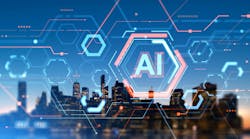As we confront climate change and address the urgent need to reduce our environmental footprint, it's important to recognize that buildings play a pivotal role. According to findings of the Global Status Report for Buildings and Construction, buildings and construction make up 37% of energy related global carbon emissions.
While these statistics indicate a major obstacle in the global pursuit of reaching the target of net-zero emissions worldwide by 2050, AI technology is emerging as a powerful ally in improving sustainability efforts within buildings and cutting costs.
AI systems can empower facilities managers (FM) to better track energy use data and serve as an assistant where humans would lack the capacity to analyze a large stream of data to make impactful, real-time determinations. Presently, the FM’s role includes finding solutions that help transform their facilities into more energy-efficient and sustainable buildings while lowering operating costs. AI brings automation to both roles, creating opportunities for greener conduct, such as dynamically addressing temperature and optimizing solar energy supply, making it possible to manage facilities in the most efficient way.
The AI revolution is upon us. To successfully execute this new technology within buildings, FMs must establish clear targets and factor in the effects and challenges that come with AI implementation.
Key Considerations for Digitizing Buildings with AI
There are several components FMs should follow before beginning an AI project. These include considerations in preparing their systems and exploring potential partnerships.
First, they need to assess their existing Building Management System (BMS) to ensure some basics are in place, such as an open architecture to easily transfer data across building systems. Second, FMs must clearly define an AI implementation's short- and long-term goals. They must determine what business goals they want to achieve and what metrics they will use to judge success moving forward. A study by McKinsey found that AI-enhanced predictive maintenance of industrial equipment can reduce maintenance costs by 10% and inspection costs by 25%. Additionally, 81% of employees believe AI improves their overall performance at work.
The last step is to complete the due diligence on potential partners. FMs should look to AI solutions that have shown a proven return on investment. Additionally, service providers should be experts in their domains and seek to collaborate with FMs daily.
Retrofitting Existing Infrastructure
With 50% of today's buildings still in use by 2050, modernizing them becomes a key opportunity for reaching net-zero goals. Renovating through the deployment of digital technologies is not only less disruptive to daily operations, but also more effective from a lifecycle carbon perspective.
Digitalization makes today’s buildings smart. IoT devices installed in buildings show double-digit annual growth, aiding sustainability by providing real-time data and enabling automated control systems. AI plays a vital role in optimizing the building’s IoT data for efficient decarbonization of facility operations.
For any AI solution to work effectively, a building must meet three requirements:
- The building must have a means of connecting the AI solution
- It must be able to collect and store data
- The building must be able to perform actions
In the case of larger buildings these requirements are relatively easy to meet. AI used in existing buildings that lack modern design practices, are likely to result in greater efficiency improvements without the need to rip and replace existing systems.
The first phase is onboarding, establishing and testing the connections between the cloud-based AI solution and the BMS. To scan the BMS for accessible data points in the building, middleware is installed. This facilitates the connections between the BMS and the cloud. This data, collected by the data points, is delivered through sensors and connected devices, classifying the data as either “observable” or “actionable.” “Observable” includes measurements like energy consumption, while “actionable” refers to a data point that can be changed, such as a temperature setpoint. Lastly, in order to verify interactions between the building and the cloud, live data tests are initiated.
Once the connection between the AI and BMS is established, the AI learning phase begins. The AI provider then remotely works to verify the data delivered by the BMS. AI training can then begin, helping the service learn how the building behaves when change occurs. This can include how indoor comfort and related energy costs are impacted if an airflow setpoint is changed. Finally, the AI model is ready to be tested–as new data arrives in the cloud, the model is retrained daily to improve accuracy.
The AI control phase can begin once the model knows building behavior. From this point, both the model and building performance continue to grow.
It’s important to note that the AI solution doesn’t need to be told how to perform but rather what the goal is. This can be what is considered good and bad in terms of indoor comfort, energy consumption or any other factor an FM considers critical.
Influence on Cost Savings and Energy Efficiency
AI tools can directly impact energy efficiency by maximizing HVAC performance through automated controls. Additionally, optimization AI learns for a month then continuously adjusts controls to maximize comfort at the lowest energy use possible. Real-time insights make it easy to understand the savings, earnings, and CO2 emissions data and make further informed decisions.
Especially in the winter months, AI tools can heavily impact energy and wellbeing. In the winter alone, AI can provide savings on electricity, savings on thermal energy, and reduced CO2 emissions.
Using AI at scale can help to avoid consuming energy during pricing peaks. At the same time, high-cost electricity usually means generating energy from carbon-based sources, such as gas or coal. However, when aiming at off-peak hours with your electricity usage, this allows the usage of green electricity to increase.
While we continue to navigate the integration of new technology, it becomes evident that AI plays a vital role to a brighter and greener future. It is imperative that we acknowledge the pressing climate and energy crisis and fully utilize the technologies available to us today to pave the way towards achieving net-zero buildings without delay.



